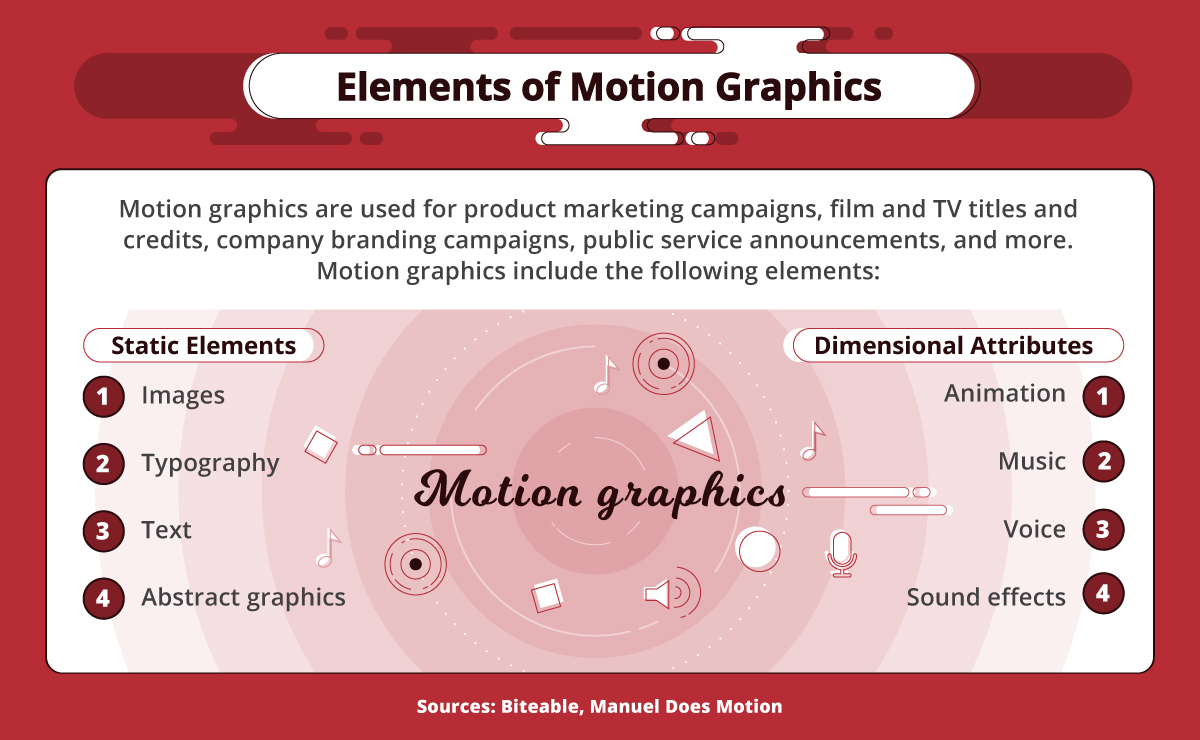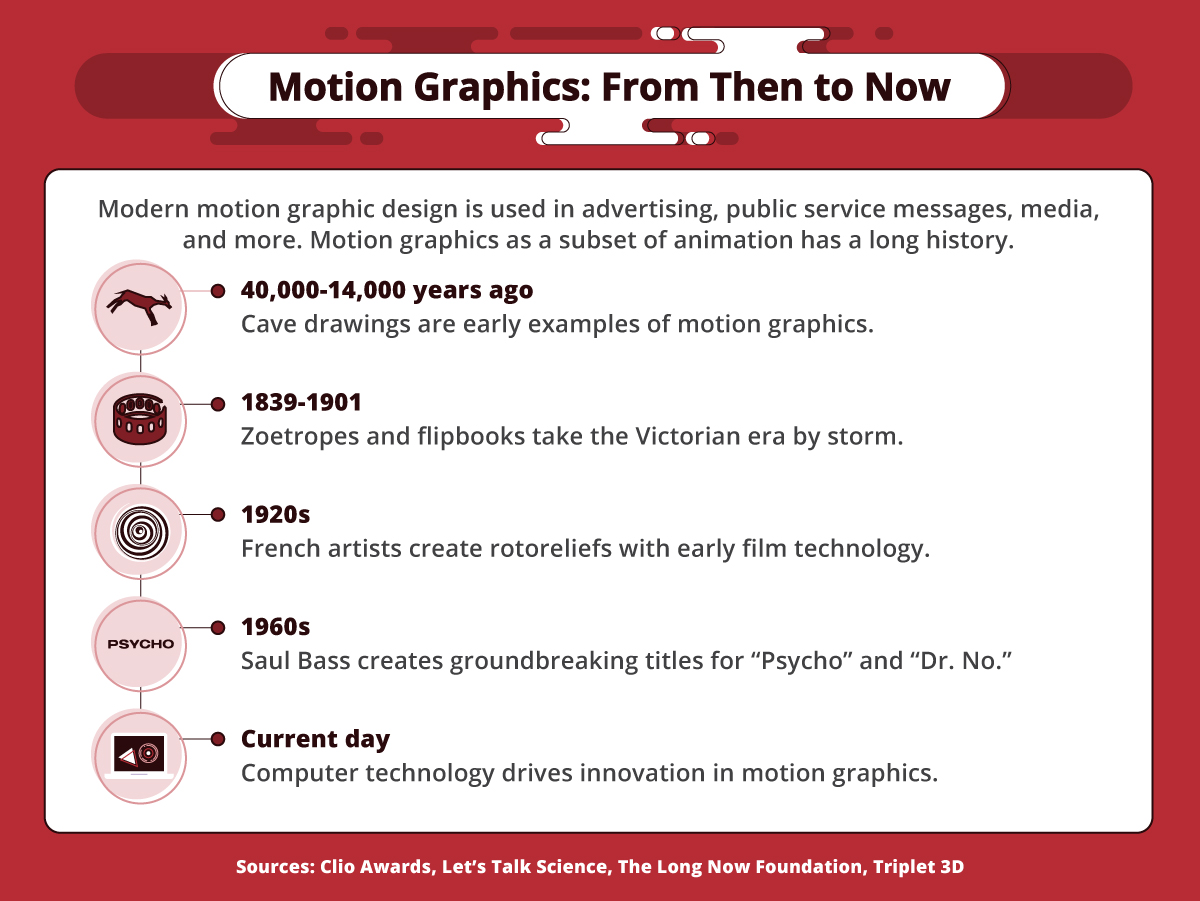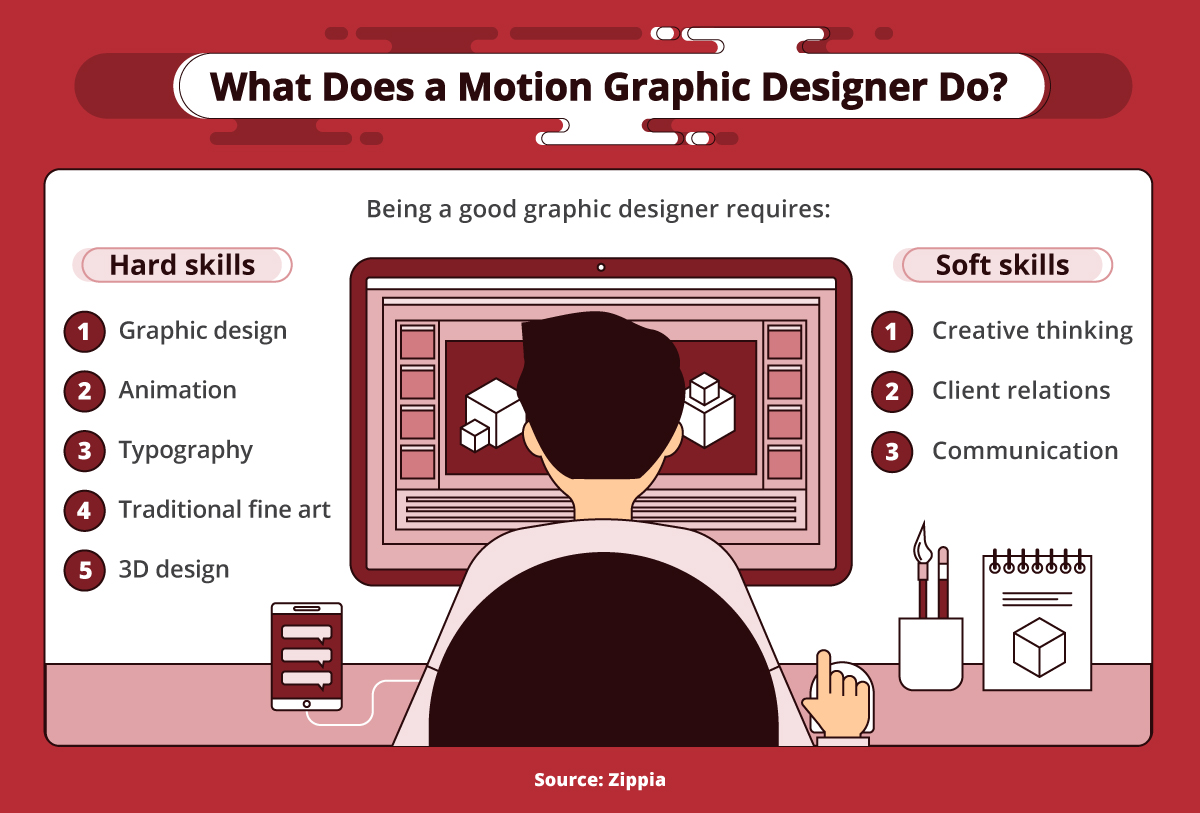Motion Graphics: Why This Eye-Catching Art Form Is in High DemandMotion Graphics: Why This Eye-Catching Art Form Is in High DemandMotion Graphics: Why This Eye-Catching Art Form Is in High Demand
Tables of Contents
Motion graphics design has long been a part of modern visual communications. Its dynamic elements are used to entertain, explain, and engage with audiences. It’s used in the opening credits and title sequences of movies and television shows, in advertising and marketing campaigns, and in educational and training videos. Motion graphics design not only enhances arts and entertainment but also is an art form in and of itself.
We can hardly imagine visual content without motion graphics, but as modern as motion graphics design is, it has a long history that predates film, television, and computers. Scientists think it’s been around for as long as humans have been telling stories.
What is motion graphics?
The best way to answer the question, what is motion graphics? is to think of it as a subset of the art of animation. Motion graphics takes a static graphic design — an advertisement or infographic, perhaps — and animates the visual elements. Motion graphics designers combine animation with music, narration, and other audio in creative ways to keep viewers engaged and watching.
Motion graphics design is highly effective at capturing viewers’ attention. It bridges the gap between static design elements, such as a magazine ad, and a live-action or animated video. Motion graphic elements tend to be short, a few minutes at most, and focus on a single message or concept. For this reason, companies are increasingly using motion graphics design in their marketing and advertising campaigns. However, motion graphics design is used in various visual arts for several different purposes.
- Movie title sequences. Artist and designer Saul Bass is known for movie title sequences that set the movie’s mood and audience’s expectations using motion graphics design.
- Television show title sequences. Title sequences for television shows, such as “The Flight Attendant,” use motion graphics for the same reason.
- Tuesday McGowan’s Android docuseries “Being Human Is” tells stories about people using Android phones to be creative and thrive.
- Education and information. Motion graphics design can be used to convey complex topics. It helps viewers visualize data, especially when the subject is complicated or difficult to understand.
With the short attention span of most audiences, motion graphics designers have to strike quickly to capture viewers’ attention and get their message across.
The elements of motion graphics design include the following:
Typography
Typography is critical to graphic design, and typeface and font help convey a message to viewers. Motion graphics design animates typography, and how it moves becomes part of the message. This is referred to as kinetic typography.
Images and graphic elements
Illustrations, abstract graphics, charts, maps, graphs, cartoons, photographs — all are graphic elements that can be animated in motion graphics design. Designers choose which elements will best convey their message and influence or educate the viewer. As with typography, the choice of graphic element depends on the market, product, and prospective audience.
Audio
Audio includes music, narration, dialogue, and sound effects. Motion graphics design incorporates all these elements. Sound is critical to conveying mood, setting a scene, and communicating a message. Designers use audio to add another dimension to motion graphics.

Motion graphics elements are used in product marketing campaigns, film and TV titles and credits, company branding campaigns, public service announcements, and more. According to Biteable and Manuel Does Motion, motion graphics designs include the following static and dimensional elements: text, typography, abstract graphics, images, animation, music, voice, and sound effects.
The difference between motion graphics vs. animation
Motion graphics is considered a subset of animation. Admittedly, the difference between motion graphics and animation can be blurry. Both use animation techniques to tell a story. Both incorporate sound to convey emotion, ambience, and meaning. Animation often uses kinetic typography or the animation of other graphic elements as part of its design aesthetic.
However, while animation includes figures and landscapes, motion graphics relies on geometric forms, typography, logos, and other graphic design elements. One test is to ask whether a piece could’ve been made using live action; if so, it’s probably animation rather than motion graphics.
Other broad differences between motion graphics and animation include the following:
- Start point. Motion graphics starts with design elements and may use storytelling to communicate a message. Animation begins with story and character.
- Style. Motion graphics animates shapes, words, and abstract images. Animation animates characters against a backdrop of graphic elements.
- Sound. Motion graphics communicates a message through mood, ambience, and narration. Animation uses sound to support a storyline.
- Intent. Designers select motion graphics as the best way to communicate information through graphic elements, sound, and animation. Animators select animation to tell a story using characters.
The history of motion graphics
The evolution of graphic design into motion graphics may seem like a modern innovation, especially with the proliferation of computers that put design tools at everyone’s fingertips. The truth is that motion graphics long predates the computer era. The history of motion graphics is the history of animation.
Paleolithic cave drawings
Between 45,000 and roughly 14,000 years ago, humans left behind astonishing cave paintings. Scientists theorize that some of these paintings were intended to represent movement when lit by firelight. If this hypothesis is correct, these are the earliest forms of animation and motion graphics.
Zoetropes and flipbooks
Zoetropes are cylinders with viewing slits that contain a scroll of a series of images. Spin the cylinder and look through the slit, and the images appear to be moving. The device was invented in 1837 and popularized in the 1860s. The first flipbook (kineograph) was patented in 1868. Flipbook illustrators drew sequential images on each page, and the viewer flipped through the pages, causing the images to appear to move.
Early film experimentation
In the 1920s, several artists took to the still new film technology to create early motion graphics. These included artists such as Marcel Duchamp, Walter Ruttman, and Fernand Leger. Duchamp created rotoreliefs (spinning drawings), and then filmed them to create a 3D animated effect. Ruttman and Leger created abstract and pop art using film and abstract graphic design. These were the first modern examples of what today we call motion graphics.
The design influence of Saul Bass
Known for his striking title sequences for such films as “Psycho,” “The Man with the Golden Arm,” and “Anatomy of a Murder,” Saul Bass has been highly influential on the field of motion graphics design. He was known for making the design elements work together in exciting and eye-catching ways. Bass has influenced many modern title designers (see, for example, the title sequences of the animated series “Archer”). These designers are making their own vibrant title sequence designs that take motion graphics to new and surprising places.
Modern demand for motion graphics designers
The entertainment and advertising industries recognize the top motion graphics designs with awards and accolades. However, it’s not just the entertainment industry that values motion graphics design. Other industries use these elements in training, education, and information sharing, reflecting just how effectively this form of design communicates information. Motion graphics designs can be viewed on phones, laptops, and tablets, as well as computer and television screens, making them easily accessible to viewers.

Modern motion graphics design is used in advertising, public service messages, media, and more. Motion graphics as a subset of animation has a long history, according to Clio Awards, Let’s Talk Science, The Long Now Foundation, and Triplet 3D. 40,000-14,000 years ago: Cave drawings are early examples of motion graphics. 1839-1901: Zoetropes and flipbooks take the Victorian era by storm. 1920s: French artists create rotoreliefs with early film technology. 1960s: Saul Bass creates groundbreaking titles for Psycho and Dr. No. Today: Computer technology drives innovation in motion graphics.
How to make motion graphics
Most designers use computer animation tools to design modern motion graphics, and various powerful software for motion graphic design exists. However, before learning how to make motion graphics, a beginning designer needs to have a solid education in foundational art and design concepts. The most important motion graphics tools are the experience and creativity that a designer brings to the table.
Before designers sit down to create the elements of their motion graphics, they go through a motion graphics development process. The process varies by designer and project, of course, but there are some general steps.
1. Create a design brief
A designer works with a client to put together a design brief that includes the project’s goals; a design aesthetic that matches the client’s brand, culture, and communication style; messaging; and elements such as color palette and logos to be incorporated. After the client approves the design brief, the designer creates a storyboard.
2. Develop a storyboard
Commonly used in film, a storyboard comprises consecutive images that lay out how the final project will be constructed. The storyboard helps a designer flesh out the design brief and develop a road map for the finished product. Motion graphics designers may use their art and design skills to sketch out a storyboard by hand. Clients can see how the design comes together and request changes or sign off on the design.
3. Assemble design elements
In motion graphics design, less is more. Designers identify the elements they’ll use and how they’ll work together. Typography, colors, abstract images, music, sound, narration, dialogue — the designer combines these elements into an effective and pleasing final product. If designers are working with a team, they’ll assign elements and manage the project and workflow.
4. Create motion graphics
After doing the preliminary work, designers employ the computer animation and graphics design tools to build their project. Motion graphics software includes scores of features that artists use to create their designs and make them sing (literally, in some cases).
What does a motion graphics designer do?
A motion graphics designer does more than just put elements of design together, serving as an artist as well as a project manager, with a solid background in graphic design, visual arts, animation, and sound. This type of designer needs to understand best practices in marketing, advertising, education, and more. Experienced motion graphics designers don’t just know how to create motion graphics designs; they know why they work. They know the right elements to choose for the right project, and they understand how to bring it all together for optimal effect.
Besides experience in the art and science behind motion graphics, effective motion graphics designers are well versed in working with clients across many industries. Motion graphics elements are popular in marketing and entertainment, but they can also be found in training, education, safety videos, and news stories.
The following are the top responsibilities of motion graphics designers:
Art and design
Graphic designers are artists first. Many designers would say that art is the reason they were drawn to their careers in the first place. To make effective motion art, designers need training in the following elements:
- Visual arts
- Typography
- Animation
- 3D design
- Sound
Professional judgment
Motion graphic designers need to understand their client’s message and goals. Relying on their experience, they then guide the client toward the most effective design. They need to understand how design elements impact viewers; this can change how they approach a project. They need to ask the following questions before they can begin creating:
- Objective. What is the goal of the design? An investment concept video is very different from a film title sequence.
- Audience. Different audiences require different approaches.
- Client brand. What is the client’s brand, culture, or history? What is its marketing presence, logo, color palette, or other identifiers?
- Look and feel. What is the client looking for? What does the client want to communicate?
Project management
After a client has approved the design brief, design elements, and storyboard, the designer shifts into project management. The day-to-day responsibilities of a motion graphics designer include the following:
- Client relations. Communication and active listening skills are crucial to meeting the client’s needs.
- Team management. Managing design teams requires delegating duties, assessing work, and solving problems.
- Workflow management. Designers are responsible for managing progress, setting and meeting interim deadlines, and making sure that the project is delivered on time.
- Budget management. Designers need to be able to operate within budget constraints.
Technical skills
Motion graphics design is a technology-heavy field. Designers need to keep up with the latest in technology to produce their work. For example:
- Design tools. Design tools, such as Adobe Illustrator and Affinity Designer, are gifts to modern motion graphics designers. Designers need a solid understanding of motion graphics principles and an ability to use these tools effectively.
- Computer hardware and software. Designers need to understand the limits of cloud storage, server requirements, computing power, and memory to be sure that they have the right equipment for the job.
- Project management software. Applications such as Trello and Basecamp help keep track of progress, deadlines, and workflow.
- Presentation software. Tools such as Canva, Powtoon, and Haiku Deck allow designers to easily present design briefs and storyboards, progress reports, and finished products to clients.

According to Zippia, being a good graphic designer requires certain hard and soft skills, including graphic design, animation, typography, traditional fine art, 3D design, creative thinking, client relations, and communication.
Motion graphics: Art and design in motion
Motion graphics design combines visual arts, graphic design, sound, and animation in exciting new ways. Designers are taking motion graphics to new levels, making even dry content engaging and informational. Powerful computer tools have opened the field to beginners, allowing them to experiment with their own ideas, and experienced designers are pushing the boundaries of what these tools can do.
Although motion graphics design has a long history — perhaps dating back to the dawn of humanity — it’s reached new significance in the modern era. Phones and tablets mean that users can view motion graphics elements anywhere. With this increase in video use, companies have turned to motion graphics to create advertising, educational materials, entertainment, and other products to get their message across with style and substance.
Next time you’re watching your favorite show, pay attention to the title sequences. If you’re doing training for work or school, notice how a video uses animation, typography, and sound to get its message across. This is the art of motion graphics design: communicating a message so a user can easily grasp its meaning, using art and animation to make the information pop off the screen.
Infographic Sources
Biteable, “What Is Motion Graphics?” Clio Awards, “2020 Clio Awards”
Let’s Talk Science, “Zoetropes”
Manuel Does Motion, “What Is Motion Design/Motion Graphics?”
Triplet3D, “The History of Motion Graphics”
Zippia, “15 Essential Motion Graphics Designer Skills for Your Resume and Career”
Be Brave
Bring us your ambition and we’ll guide you along a personalized path to a quality education that’s designed to change your life.

